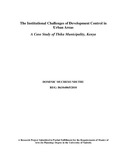| dc.description.abstract | Urbanization is the process by which large numbers of people become permanently concentrated in relatively small areas, forming cities. Land use planning is concerned about how a space can be utilised sustainably with its functionality potential at the optimum. There are both legal and policy frameworks, supplemented with town by-laws that ensure there is order in the manner by which urban space is utilised. In Kenya there are several related Acts of Parliament, approved development plans and zoning regulations. However, irrespective of the assumably robust policy, legal and institutional framework, urban areas in Kenya are still characterized by incongruent structures, inadequate roads, among others with less regard to environmental sustainability, the character of the urban space, the aesthetics, etc, suggesting that development control is still a mirage. This study conducted an analytical evaluation of the institutions surrounding development control and to establish the operational challenges facing development control in Kenya‘s urban areas. This was done by focusing on the following specific objectives; examining the actual development control process as applied in Thika Municipality; establishing the challenges behind the current level of development control in Thika Municipality; and proposing policy guidelines to improve development control regime in Kenya. The geographical scope of the study was Thika Municipality. By research design this was an exploratory study. It adopted a case study approach. It sampled its respondents judgmentally since it was dealing with very few key informants as revealed by the existing urban management organizational structure of Thika Municipality. The variable scope was limited to analyzing the institutional challenges variables within development control. These included the fundamentals of development management; the development control process adopted; and who are involved in the decision-making process for development control in urban areas concerned among others. The study found out that weaknesses in the Physical Planning Act as a legislature, lack of a spatial planning framework, limited human resource capacity and fear of change from the old legal order to the new dispensation in terms of embracing the new County Government Act and the Urban Areas and Cities Act, are majorly responsible for the institutional and capacity challenges facing development control in Thika Municipality. The study recommends enactment of a new PPA, embracing the new urban management systems through the provisions in the Urban Areas and Cities Act and County Government Act thanks to the devolved governance structure, and also improving the level of participation as required by law and employing diverse human resource personnel. | en_US |

